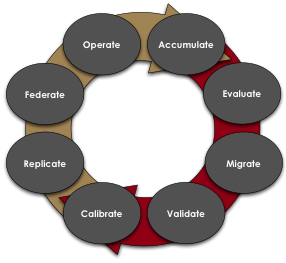Nathan Biggs (@nathanbiggs), CEO
I often get asked the question of “What does House of Brick do?” The tagline that I have been using most is “House of Brick is the leader in the virtualization and Cloud Computing for business critical systems.” Given some of the lack of definition around Cloud Computing (not only at House of Brick, but industry-wide), I thought that I would provide some background as to why I think that statement fits what we do.
House of Brick is the leader in the virtualization and Cloud Computing for business critical systems.
Let me work backwards through that statement in breaking things down.
Business Critical Systems
Our definition of a business critical system is one that might be unique to House of Brick. I know of several other companies that use 
From the perspective of House of Brick’s customers, the term business critical (or in the case of schools or non-profits, I usually switch to use the term mission critical) refers to those systems that are most vital to their operations and business success. When I talk to groups of customers I usually affirm to them that, “If your business critical system goes down it is not just an inconvenience…you are losing money.”
From a technical or architectural point-of-view, we define business critical systems as the entire stack from the application through middleware, database, operating system, virtualization layer, server infrastructure, storage, and network. That focus on the entire application system stack is something that makes House of Brick fairly unique. There are many consulting companies that focus on applications (such as SAP or EBS), and many that focus on the database (Oracle or SQL Server). What there are not a lot of is companies like us that have a more holistic perspective on what it takes to keep business critical systems running well.
LIFECYCLE OF BUSINESS CRITICAL SYSTEMS

- Accumulate — Gather system information, and customer requirements in order to create an architecture that fits our customer’s needs.
- Evaluate — Analyze those requirements and system data and design the appropriate architecture. Use resource availability, timing deadlines, and SLA requirements to develop the implementation project plan.
- Migrate — Move the application from one platform to another. Many times this is a virtualized infrastructure on the target end. Also migrate the data into that application respecting established SLA requirements.
- Validate — Validate the results once the application and data are on the new platform. This includes a functional validation, as well as data integrity, and system performance.
- Calibrate — Performance-tune the system stack to meet or exceed customer expectations, and House of Brick best practices.
- Replicate — Establish High Availability (HA) and Disaster Recovery (DR) solutions for the customer’s systems.
- Federate — This is a Cloud Computing term that refers to the use of all available system resources for that application. The needs of the application may grow or shrink depending on weekly, monthly, quarterly, or annual demand. It may also be dependent on non-timing factors. We establish principles of Cloud Computing when we allow that application to be moved or take up more or less resources as needed.
- Operate — The operate phase is probably the longest of any of the others combined, or at least ideally so. House of Brick shines in this phase with our Managed Consulting Services, and the proactive nature of the way we try to keep our customers’ systems healthy.
VIRTUALIZATION MATURITY MODEL
Finally, a business critical system (system stack and associated lifecycle) needs to fit within an organization. Many times an organization must change or mature in order to adequately adopt a virtualization or Cloud Computing model. Giving full acknowledgement to House of Brick PA Jim Hannan for the development of this concept and diagram, I am including the Virtualization Maturity Model as illustrated in the following.
We have traditionally helped customers through the performance stage of this model, but we see tremendous opportunities to help our customers as we have started to move conversations into the right side activities.
Next week’s blog post: I will continue to discuss our vision for cloud computing describing HoB’s focus on the virtualization of server infrastructure.







